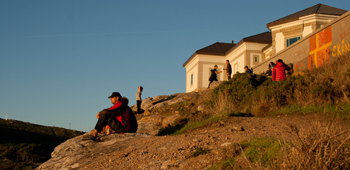Fisterra. The End of the Way.
Finisterre. The Journey’s end from FisterraTV on Vimeo.
The idea of pilgrimage to the most western lands of Europe was already present in the beliefs of celtic people. This beliefs were related to the journey that the sun makes every day.
The close relationship between Fisterra and St James was the reason why Fisterra´s Way was one of the first routes that pilgrims set foot on.
In the XII century Duio´s city is mentioned in the Calixtinus Codex ( Book III). According to ancient testimonies, in Fisterra there was an old pagan city called Dugium. This is the place where the remains of the Apostle passed through in order to be buried here. The Apostle´s disciples asked permission to the region´s Queen. She is called Lupa. She refers them to Dugium´s governor, who orders an ambush, but when the plan is discovered they manage to escape.
The antiquity of this route is confirmed by documents dated in 1119. These documents mention the concern of the King Alfonso VII and San Julián de Moraime´s Abbot to provide accommodation for pilgrims who came to the area. In 1355, a pilgrim called George Grisaphan describes his pilgrimage to Fisterra in his diary. Years later more pilgrims like León de Rosmithal in 1465, Sebaldo Rieter in 1462, Erich Lassota in 1581 and Julián Iñiguez de Medrano in 1583 related their pilgrimages to the end of the land.
Thanks to the pilgrims´s costum to arrived to the End of the Way and perform the rituals of bathing and see the sunset, we have a wide collection of journeys by walkers from the Middle Ages. This confirms the antiquity of Fisterra´s route.
Fisterra´s Way it´s the only Way that has not it´s finish in Santiago, it has it´s origin in Santiago. Nowadays this Way it´s a ritual followed by a lot of pilgrims, who wish to reach the Finis Terrae to continue enjoying the route and discover some of the most impressive places in the western European coast.

 Galego
Galego  Español
Español 
